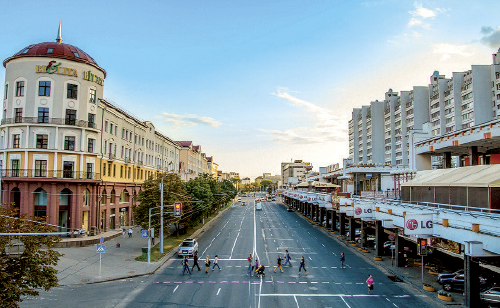Minsk’s Nemiga Street is hardly Atlantis but does regularly flood in spring. This year was no exception. However, local authorities have assured residents that a new catch basin should solve the problem. Ecologists are less confident that nature can be deceived, since the River Nemiga continues to flow beneath the asphalt road.

Minsk’s Nemiga Street: previously, a river with the same name was running here
Andrey Pilipchuk, who heads the Natural Resources and Environmental Protection Ministry’s Department, refers to Seoul’s Jongno-gu River as a good example, which has been flowing under a road for almost 50 years. Just a few years ago, Seoul’s Mayor decided to relieve the city’s air pollution by creating a natural area, allowing 6km of the river to flow upwards. Many thought his idea crazy but the city now has a picturesque corner, favoured by all seeking relaxation. Numerous cafes and restaurants have sprung up to serve visitors and walkers while tourist routes and exhibitions have generated much revenue to the city’s budget.
 Mr. Pilipchuk has no doubt that a similar solution can be applied in Minsk, with the street transforming into a river where Nemiga metro station meets MacDonald’s. Old Minsk could become a pedestrian oasis, attracting tourists. “We’ll kill two birds with one stone: alleviating traffic and urban pollution in the city centre, while creating a comfortable zone for tourists, with museums, Orthodox and Roman Catholic churches, restaurants serving national cuisine and shopping areas. We can lay out walking routes, directing people to little known sites — such as the Vankovichs’ House, an old monastery and a Roman Catholic church,” the ecologist explains. “At the moment, our Upper Town is almost fully pedestrianised. A horse drawn fire-fighting vehicle may occasionally be seen shuttling past the Cathedral, through Internatsionalnaya, Gertsen and Kirill and Mefody streets, which were paved. Souvenir shops could open around Troitsky Suburb, alongside bicycle routes, while electric trams and other e-transport could come into use. We could host diverse cultural events — such as concerts, exhibitions and theatrical performances — near the National Museum.”
Mr. Pilipchuk has no doubt that a similar solution can be applied in Minsk, with the street transforming into a river where Nemiga metro station meets MacDonald’s. Old Minsk could become a pedestrian oasis, attracting tourists. “We’ll kill two birds with one stone: alleviating traffic and urban pollution in the city centre, while creating a comfortable zone for tourists, with museums, Orthodox and Roman Catholic churches, restaurants serving national cuisine and shopping areas. We can lay out walking routes, directing people to little known sites — such as the Vankovichs’ House, an old monastery and a Roman Catholic church,” the ecologist explains. “At the moment, our Upper Town is almost fully pedestrianised. A horse drawn fire-fighting vehicle may occasionally be seen shuttling past the Cathedral, through Internatsionalnaya, Gertsen and Kirill and Mefody streets, which were paved. Souvenir shops could open around Troitsky Suburb, alongside bicycle routes, while electric trams and other e-transport could come into use. We could host diverse cultural events — such as concerts, exhibitions and theatrical performances — near the National Museum.”
Car parking would be constructed near the metro station, for citizens’ convenience, so that people could enter the old town on foot or by public transport.
Novopolotsk and Novogrudok are very much ‘green cities’, having enjoyed investment through a UNDP and Global Environment Facility project (worth around $5m), these cities should enjoy better ecology within just three years (fr om 2015). Novopolotsk is focusing on clean transport while Novogrudok is transforming its lighting system. In addition, Polotsk and Novopolotsk will soon be connected by a new tram route and a second bridge (for trams, pedestrians and cyclists). Importantly, these plans envisage a whole new transport solution, helping balance Novopolotsk’s two major sources of pollution: Naftan enterprise and city transport.
Two more Belarusian cities will soon turn ‘green’, united by common energy efficient architecture, reduced transport emissions and a shift to solar and wind-powered generators. In addition, these cities are to enjoy greater use of electrified transport and sloping roofs on which flowers may be grown, to consume carbon-dioxide emissions. Other innovations are planned to work towards a carbon neutral stance: the goal of any ‘green’ city. The UAE’s Masdar aims to reach this target by 2023, while Copenhagen promises to become the first capital to gain complete carbon neutrality, with zero greenhouse gas emissions by 2025. France, the UK and China are also moving in the same direction, although Mr. Pilipchuk is convinced that the situation in London (wh ere air appears thick with smog) is much worse than in any Belarusian city. Of course, the time for action always comes eventually. London’s introduction of ‘the congestion charge’ and raised parking charges (£2 per hour, compared to just 20p outside the zone) are deterring some volume of traffic. It simply makes sense to park near a metro station and take public transport — as is being promoted also in Moscow.
Mr. Pilipchuk is convinced that Minsk needs to plan for eco-city status, since it rivals Rome, Madrid, Barcelona and Vienna in having 600 cars per 1,000 citizens. Transport is responsible for most air pollution (over 70 percent) so it’s time to make changes.











